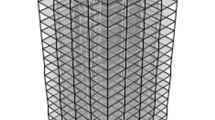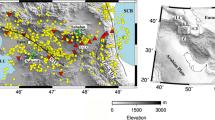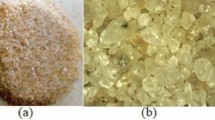Abstract
The strong motion of a small long and narrow basin caused by a moderate scenario earthquake is simulated by using the spectral-element method and the parallel computing technique. A total of five different geometrical profiles within the basin are used to analyze the generation and propagation of surface waves and their relation to the basin structures in both the time and frequency domain. The amplification effects are analyzed by the distribution of peak ground velocity (PGV) and cumulative kinetic energy (Ek) in the basin. The results show that in the 3D basin, the excitation of the fundamental and higher surface wave modes are similar to that of the 2D model. Small bowls in the basin have great influence on the amplification and distribution of strong ground motion, due to their lateral resonances when the wavelengths of the lateral surface waves are comparable to the size of the bowls. Obvious basin edge effects can be seen at the basin edge closer to the source for constructive interference between direct body waves and the basin-induced surface waves. The Ek distribution maps show very large values in small bowls and some corners in the basin due to the interference of waves propagating in different directions. A high impedance contrast model can excite more surface wave modes, resulting in longer shaking durations as well as more complex seismograms and PGV and Ek distributions.
Similar content being viewed by others
References
Anderson JG, Bodin P, Brune JN, et al. (1986), “Strong Ground Motion from the Michoacan, Mexico, Earthquake,” Science, 233(4768): 1043–1049.
Bao H, Bielak, J, Ghattas O, et al. (1998), “Largescale Simulation of Elastic Wave Propagation in Heterogeneous Media on Parallel Computers,” Comput. Methods Appl. Mech. Engrg., 152: 85–102.
Bard PY and Bouchon M (1980a), “The Seismic Response of Sediment-filled Valleys. Part 1. The Case of Incident SH Waves,” Bull. Seism. Soc. Am., 70(4): 1263–1286.
Bard PY and Bouchon M (1980b), “The Seismic Response of Sediment-filled Valleys. Part 2. The Case of Incident P and SV Waves,” Bull. Seism. Soc. Am., 70(5): 1921–1941.
Chen, KC (2003), “Strong Ground Motion and Damage in the Taipei Basin from the Moho Reflected Seismic Waves during the March 31, 2002, Hualien, Taiwan Earthquake,” Geophys. Res. Lett., 30: 1151–1154.
Clayton R and Engquist B (1977), “Absorbing Boundary Conditions for Acoustic and Elastic Wave Equations,” Bull. Seism. Soc. Am., 67: 1529–1540.
Delavaud E, Cupillard P, Festa G, et al. (2006), “3D Spectral Element Method Simulations of the Seismic Response in the Caracas Basin,” Third International Symposium on the Effects of Surface Geology on Seismic Motion, Grenoble, France, pp. 1–8.
Graves RW, Pitarka A and Somerville PG (1998), “Ground-motion Amplification in the Santa Monica Area: Effects of Shallow Basin-edge Structure,” Bull. Seism. Soc. Am., 88(5): 1224–1242.
Haskell N (1960), “Crustal Reflection of Plane SH waves,” J. Geophys. Res., 65(12): 4147–4150.
Horike M, Uebayashi H and Takeuchi Y (1990), “Seismic Response in Three-dimensional Sedimentary Basin due to PlaneS Wave Incidence,” J. Phys. Earth, 38: 261–284.
Kawase H (1996), “The Cause of the Damage Belt in Kobe: ‘The Basin-edge Effect,’ Constructive Interference of the Direct S-Wave with the Basin-Induced Diffracted/ Rayleigh Waves,” Seismological Research Letters, 67(5): 25–34.
Kim MK, Lee JS and Kim MK (2003), “Two-Dimensional Seismic Response Analysis of Basin Effects,” KSCE Journal of Civil Engineering, 7(1): 33–39.
Komatitsch D, Liu QY, Tromp J, et al. (2004), “Simulations of Ground Motion in the Los Angeles Basin Based upon the Spectral-element Method,” Bull. Seism. Soc. Am., 94(1): 187–206.
Lee J (2013), “Earthquake Site Effect Modeling in the Granada Basin Using a 3-D Indirect Boundary Element Method,” Physics and Chemistry of the Earth, 63: 102–115.
Lee SJ, Chen HW and Huang BS (2008a), “Simulations of Strong Ground Motion and 3D Amplification Effect in the Taipei Basin by Using a Composite Grid Finite- Difference Method,” Bull. Seism. Soc. Am., 98(3): 1229–1242.
Lee SJ, Chen HW, Liu QY, et al. (2008b), “Threedimensional Simulations of Seismic-wave Propagation in the Taipei Basin with Realistic Topography Based upon the Spectral-element Method,” Bull. Seism. Soc. Am., 98(1): 253–264.
Liao, WI (2011), “Dynamic Responses of a Sedimentfilled Valley with a Fluid Layer Subject to Incident Waves,” Earthquake Engineering and Engineering Vibration, 10(2): 175–185.
Liu QF, Li XQ and Sun PS (2013), “Study on the 3-D Velocity Model of Shidian Basin,” Journal of Earthquake Engineering and Engineering Vibration, 33(3): 88–96. (in Chinese)
Olsen KB (2000), “Site Amplification in the Los Angeles Basin from Three-dimensional Modeling of Ground Motion,” Bull. Seism. Soc. Am., 90(6B): S77–S94.
Olsen KB and Schuster GT (1995), “Causes of Lowfrequency Ground Motion Amplification in the Salt Lake Basin: the Case of the Vertically IncidentP Wave,” Geophys. J. Int., 122: 1045–1061.
Paudyal YR, Yatabe R, Bhandary NP, et al. (2012), “A Study of Local Amplification Effect of Soil Layers on Ground Motion in the Kathmandu Valley using Microtremor Analysis,” Earthquake Engineering and Engineering Vibration, 11(2): 257–268.
Pilz M, Parolai S, Stupazzini M, et al. (2011), “Modelling Basin Effects on Earthquake Ground Motion in the Santiago de Chile basin by a Spectral Element Code,” Geophys. J. Int., 187: 929–945.
Pitarka A, Irikura K, Iwata T, et al. (1998), “Threedimensional Simulation of the Near-fault Ground Motion for the 1995 Hyogo-Ken Nanbu (Kobe), Japan, Earthquake,” Bull. Seism. Soc. Am., 88(2): 428–440.
Semblat JF, Dangla P and Kham M (2002), “Seismic Site Effects for Shallow and Deep Alluvial Basins: In-Depth Motion and Focusing Effect,” Soil Dynamics and Earthquake Engineering, 22: 849–854.
Wang CY, Mooney WD, Wang XL, et al. (2002), “Study on 3-D Velocity Structure of Crust and Upper Mantle in Sichuan-Yunnan Region,” Acta Seismologica Sinica, 24(1):1–16. (in Chinese)
Yuan YF, Yang BP and Huang SD (1992), “Damage Distribution and Estimation of Ground Motion in Shidian (China) Basin,” Proceedings of the International Symposium on the Effects of Surface Geology on Seismic Motion, Vol. I, Odawara, Japan, pp. 281–286.
Zhang N, Gao YF, Yang J, et al. (2015), “An Analytical Solution to the Scattering of Cylindrical SH Waves by a Partially Filled Semi-circular Alluvial Valley: Nearsource Site Effects,” Earthquake Engineering and Engineering Vibration, 14(2): 189–201.
Author information
Authors and Affiliations
Corresponding author
Additional information
Supported by: National Natural Science Foundation of China under Grant No. 51078337, No. 51108431 and No. 91315301
Rights and permissions
About this article
Cite this article
Liu, Q., Yu, Y. & Zhang, X. Three-dimensional simulations of strong ground motion in the Shidian basin based upon the spectral-element method. Earthq. Eng. Eng. Vib. 14, 385–398 (2015). https://doi.org/10.1007/s11803-015-0031-4
Received:
Accepted:
Published:
Issue Date:
DOI: https://doi.org/10.1007/s11803-015-0031-4




